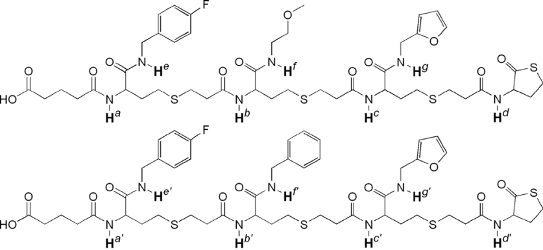Modeling of multi-functionalized, sequence-controlled polymers
Modeling of multi-functionalized, sequence-controlled polymers
Promotor(en): K. Hemelsoet, V. Van Speybroeck /MM_14_CHEM_04 / Chemistry & BiochemistryProblem
Controlled synthesis of complex macromolecules enables the design of new materials with promising applications to nanotechnology. Current approaches for the synthesis of functionalized macromolecular structures, though providing a high degree of structural and topological control, lack the ability to control the polymer microstructure. Crucial parameters like monomer sequence and tacticity largely remain unmastered by current man-made approaches. Recently, researchers from the Polymer Chemistry Research group have developed a new coupling strategy for the controlled generation of sequence-defined multi-functionalized oligomers on solid support by using thiolactone-based chemistry [2]. The next big challenge is: how can we leverage this new synthesis strategy to design tailor-made materials with e.g. certain catalytic or bio-sensing properties?
Goal
In this thesis, the folding and self-association behavior of the obtained sequence-defined oligomers will be determined with molecular modeling techniques. The Figure shows some synthesized trimeric compounds. The goal is to provide crucial insights into the relationship between the folding and self-assembly properties on one hand and the chain length and the identity of the side groups on the other hand. This model-guided design will be conducted in close collaboration with an experimental research group.As a first step, several molecular mechanics force fields will be tested on their ability to accurately describe the structural properties of the formed oligomers. Once a suitable force field is selected, the dynamic behavior of the solvated oligomers will be assessed with molecular dynamics. The chain length will vary from 3 to 5 units and a variety of side groups will be examined.
This master thesis is challenging and focuses on recent breakthroughs in the exciting field of polymer chemistry. A combination of theory and experiment is needed to understand the structure and behavior of these flexible materials. This topic is ideally suited for a student who has a strong interest in the detailed molecular structure of large molecules. The proposed theoretical simulations are no routine business yet, and hence the interested student really has the opportunity to contribute to this field. There will be a strong coaching from researchers at the CMM, and there will also be discussions with researchers from the experimental PCR group.
[1] Espeel P, Carrette LL, Bury K, Capenberghs S, Martins JC, Du Prez FE, Madder A. Multifunctionalized sequence-defined oligomers from a single building block. Angew Chem Int Ed Engl. 2013, 52(50):13261-4.
- Study programmeMaster of Science in Chemistry [CMCHEM], Master of Science in Physics and Astronomy [CMFYST]KeywordsMolecular modeling, Polymers, Molecular dynamicsRecommended coursesSimulations and Modeling on the Nanoscale, Molecular Simulations of Biosystems

